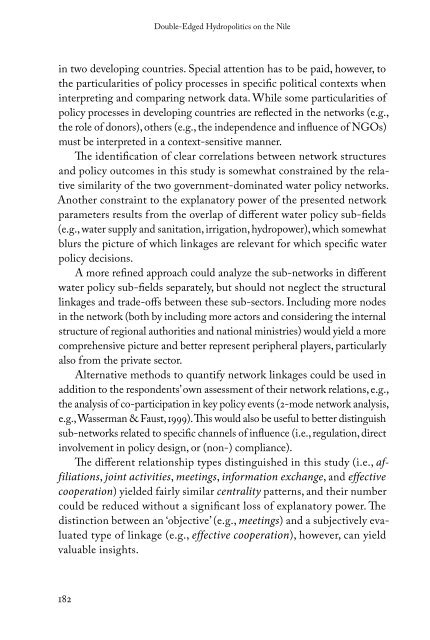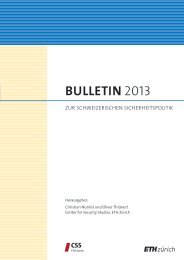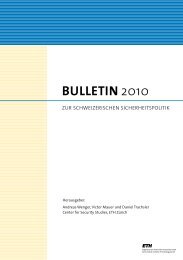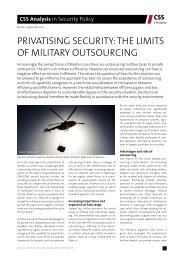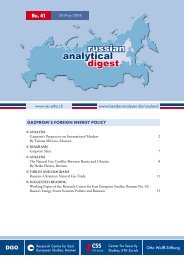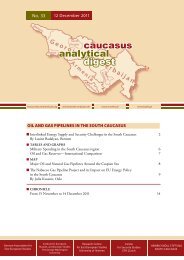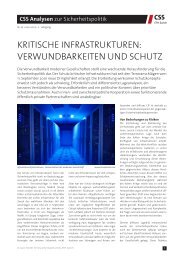Double-Edged Hydropolitics on the Nile - Center for Security Studies ...
Double-Edged Hydropolitics on the Nile - Center for Security Studies ...
Double-Edged Hydropolitics on the Nile - Center for Security Studies ...
You also want an ePaper? Increase the reach of your titles
YUMPU automatically turns print PDFs into web optimized ePapers that Google loves.
<str<strong>on</strong>g>Double</str<strong>on</strong>g>-<str<strong>on</strong>g>Edged</str<strong>on</strong>g> <str<strong>on</strong>g>Hydropolitics</str<strong>on</strong>g> <strong>on</strong> <strong>the</strong> <strong>Nile</strong><br />
in two developing countries. Special attenti<strong>on</strong> has to be paid, however, to<br />
<strong>the</strong> particularities of policy processes in specific political c<strong>on</strong>texts when<br />
interpreting and comparing network data. While some particularities of<br />
policy processes in developing countries are reflected in <strong>the</strong> networks (e.g.,<br />
<strong>the</strong> role of d<strong>on</strong>ors), o<strong>the</strong>rs (e.g., <strong>the</strong> independence and influence of NGOs)<br />
must be interpreted in a c<strong>on</strong>text-sensitive manner.<br />
The identificati<strong>on</strong> of clear correlati<strong>on</strong>s between network structures<br />
and policy outcomes in this study is somewhat c<strong>on</strong>strained by <strong>the</strong> relative<br />
similarity of <strong>the</strong> two government-dominated water policy networks.<br />
Ano<strong>the</strong>r c<strong>on</strong>straint to <strong>the</strong> explanatory power of <strong>the</strong> presented network<br />
parameters results from <strong>the</strong> overlap of different water policy sub-fields<br />
(e.g., water supply and sanitati<strong>on</strong>, irrigati<strong>on</strong>, hydropower), which somewhat<br />
blurs <strong>the</strong> picture of which linkages are relevant <strong>for</strong> which specific water<br />
policy decisi<strong>on</strong>s.<br />
A more refined approach could analyze <strong>the</strong> sub-networks in different<br />
water policy sub-fields separately, but should not neglect <strong>the</strong> structural<br />
linkages and trade-offs between <strong>the</strong>se sub-sectors. Including more nodes<br />
in <strong>the</strong> network (both by including more actors and c<strong>on</strong>sidering <strong>the</strong> internal<br />
structure of regi<strong>on</strong>al authorities and nati<strong>on</strong>al ministries) would yield a more<br />
comprehensive picture and better represent peripheral players, particularly<br />
also from <strong>the</strong> private sector.<br />
Alternative methods to quantify network linkages could be used in<br />
additi<strong>on</strong> to <strong>the</strong> resp<strong>on</strong>dents’ own assessment of <strong>the</strong>ir network relati<strong>on</strong>s, e.g.,<br />
<strong>the</strong> analysis of co-participati<strong>on</strong> in key policy events (2-mode network analysis,<br />
e.g., Wasserman & Faust, 1999). This would also be useful to better distinguish<br />
sub-networks related to specific channels of influence (i.e., regulati<strong>on</strong>, direct<br />
involvement in policy design, or (n<strong>on</strong>-) compliance).<br />
The different relati<strong>on</strong>ship types distinguished in this study (i.e., affiliati<strong>on</strong>s,<br />
joint activities, meetings, in<strong>for</strong>mati<strong>on</strong> exchange, and effective<br />
cooperati<strong>on</strong>) yielded fairly similar centrality patterns, and <strong>the</strong>ir number<br />
could be reduced without a significant loss of explanatory power. The<br />
distincti<strong>on</strong> between an ‘objective’ (e.g., meetings) and a subjectively evaluated<br />
type of linkage (e.g., effective cooperati<strong>on</strong>), however, can yield<br />
valuable insights.<br />
182


